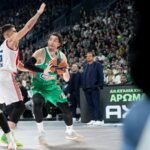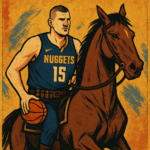
This is the first full season and the influence of IMG over Euroleague is already more than obvious according to Emmet Ryan. In BiE’s sort-of annual state of the union style piece on Final Four week, we look at how the new look is more than just a change in format
Gumption and talent were never lacking in Euroleague’s offices. Bodies and resources however were. The Euroleague in-house media team are tasked with a ridiculously broad brief, forcing so much segmentation from such a small crew that their ceiling was obvious. In short, to get to the next level there needed to be something else.
That’s what the partnership with IMG has essentially provided. The ceiling is far from clear now but it’s a lot further up than it used to be and it all, as is the case with far more projects than it ought to be, begins with the visibly small stuff.
Just take the entire game presentation. The opening titles, the pre-game videos in the locker room, and the more active use of content during breaks. These aren’t huge things but it’s about buying into the idea that if Euroleague cares about looking like a big deal more people will see it as a big deal. The game-break content is the least obvious but most important here. With no studio team for the global feed, the natural flip was to highlights. That’s what it still is now only it sounds like the commentator is paying attention and trying to grab the viewer’s attention whereas before they were essentially allowed to leave it play to kill time.
It’s the little pieces here that bring it together. When you flip on a game, the broadcast is designed to engage you throughout. This matters commercially as not every game is going to sell itself. You can take a certain chunk of viewers for granted throughout, the absolute die-hards for whom the Devotion theme is basically about. A far greater portion of viewers are more casual. They don’t have the same automatic commitment to what’s on. It’s a choice for them to tune in and they will, either directly or just mentally, tune out if their attention isn’t maintained.
Blow-outs happen, as do bore-fests, and just plain predictable games. Collectively, these will wildly outnumber slobberknockers. For your bread and butter, you’ve got to give the viewer a reason to stay alert. That’s where the upgrade in presentation makes a different as advertisers and sponsors know from seeing the product that more viewers are going to stay fully tuned in throughout.
Year one under the new format hasn’t all been about IMG, well duh, but having that neat dressing really helped what was an all but ideal* year for Euroleague in terms of on-court results. Swap out Dacka for a healthy Crvena Zvezda and you basically have the optimal eight team playoff feed for long-term marketing. Even then, the commercial switch isn’t that big an issue especially with the clear storylines that ran through the year.
*Maccabi, you are financially vital but you always will be. Having an upstart there for year one is better for the long-term as hope is the most important product to sell in sports.
Bamberg’s inability to close, the rocky road for Fener, the are they/aren’t they back tale with Panathinaikos (the answer appeared to be ‘sort of’ come the end), Real’s ability to look like both the best team and an at-times vulnerable side all at once. That’s just the beginning chunks before the excellent roles Galatasaray and Unics Kazan played as spoilers throughout. No game really felt like an absolute gimme before opening tip or at least none that did really proved to be unless you count many, many, Olimpia Milano games.
The raids by the NBA over the past two summers had folks wondering about the quality level to some degree and the 16 sides answered with authority. Star power sells and while new stars were born it was more of a case that more players embraced their enhanced roles with authority. Luka Doncic is the obvious legit new star but we were betting on him as fans. The growth of Sergio Llull from fun guy who occasionally goes to hell into fun guy who occasionally enters kill everything beast mode essentially came because he was given the chance to do that.
The on-court product will never be perfect, sport as a concept would actually be awful if perfection was achieved, but it’s more than comfortably going in the right direction. Depth appears visible despite a collection of superpowers together in the Final Four.
With the on-court product in, certainly on the depth side, the place it needs to be the next level comes in the off court side. The Insider series from Euroleague is a great indicator of what is to come but that qualifier is important. As individual shows, the Insider episodes do a great job in telling the stories of the league in a manner that looks really professional. Selling those stories creates stickiness, it makes fans more attached to what’s going on and, thusly, makes them more valuable to advertisers because they identify more with the overall product.
A whole lot more can be done however on the engagement part. Now, let’s be clear, changing everything in a single year would not only have been impossible it would have been dumb to try. You find a thing, build it, make it great, then find something else to do that with.
The overall content level the Euroleague site during the week has gone up but more editorial investment makes sense here not just because more good journalism is a good thing. It is barmy to this corner that, considering a bunch of semi pros and amateurs across Europe can put together well received podcasts from their bedrooms (Sweet 16, Euroleague Adventures, Taking the Charge) or possibly cleaner rooms but there are none from Euroleague HQ itself. It’s not for lack of broadcast talent, they have that, or in-house journalistic talent, ditto, or access to key people, they have all of that. This is just a no-brainer for a weekly series next year, even building around one key interview a week with a two or three head studio side with Euroleague’s own in-house talent. People will definitely tune in and it also creates more engagement with fans.
That fan engagement side is the big open battlefield for Euroleague to go after as no sport in Europe is actually doing a good job of it right now, not even football. Well, you could argue rugby but you’d be wrong. Right now there’s actually not enough fragmentation in the sports social media game, whereas usually the issue is too much.
Snapchat, Instagram, Facebook, Twitter, VK, and whatever’s next don’t just have different hardcore audiences. They have different sub-sets within each medium and different messages are expected from each. In my day job I’m fortunate to have a broad range of freelance staff working under me and what is a media job today is really different from when I started full-time 11 years ago. I’ve got a writer working from me is as a Snapchat sub-editor, as in they re-package content to make it digestible on Snapchat and only Snapchat. That job exists because serving that part of the market and maximising its interest requires it to. Readers under 25 will go ‘Well duh’ but anyone older reading (90 per cent of our readers are 18-45) is going to be a little taken aback.
That’s the level of detail that has to be the goal but getting there doesn’t require one great leap. Go with a plan network by network, look at what you can invest, if you are the poor schmuck tasked with the job then tell the person above you that you need more money, if you are that higher person agree with them, and work out what you can do to improve fan engagement on each platform.
When you’ve got a good product, you don’t sit back. You get to work on the why people like it and how they can be made to like it more. If you do that, you build advocates not just customers. The best way to do that is to make the individual fan think of themselves as empowered part of a broader constituency. You do that, you build the revenue per customer and make more people want to be customers.
There are some positives here. The overall picture is actually quite rosy. This year saw the app actually become relevant, it only took a few years, and the live streams managed to work consistently without Twitter becoming awash with folk complaining about them. The open field that is there is now one that can be attacked and the focus appears to be there to do so. Contrast that with this column three years ago which was essentially asking if Euroleague knew what Euroleague wanted to be.
Where we go from here is open to plenty of conjecture and includes remembering this league doesn’t exist on an island. The Basketball Champions League and, with it, the impact on Eurocup is going to merit watching in terms of how it influences the overall product growth. Fattening the top is welcome if worthwhile for Euroleague but to do that it will see control as paramount. The willingness to invest in the off court product to keep fan interest for seasons where the on court output isn’t necessarily as good will matter. Ambition and sustainability are best when treated in tandem rather than as rivals.
For a few days in Istanbul, it’s going to be all about the hoops. Enjoy the games, then get ready for the next step.




Leave a Reply